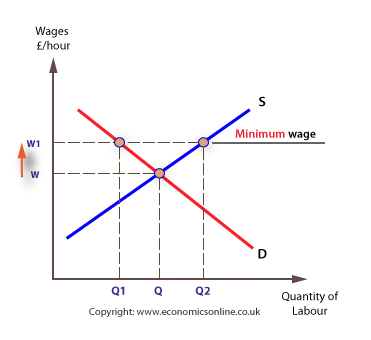- Labour market: a place where employers and employees meet to exchange labour for wage.
- Demand for labour: the number of workers that firms are willing and able to hire at each wage rate.
- Demand for labour is a derived demand.
- As wages increase, the demand of labour decreases.
- The demand curve is downward sloping because firms are willing and able to hire more workers at a lower wage rate.
- Shifts of the demand curve: demand for the good, productivity of workers, capital (quality or price of machines).
- Supply of labour: the number of workers that are willing and able to work at each wage rate.
- Shifts of the supply curve: wages in substitute jobs, barriers to entry, non-monetary considerations, occupational mobility, working population, value of leisure, expectations.
- Geographical immobility of labour is affected by: time and cost to settle, social life, friends and family.
- Occupational immobility of labour is affected by: lack of transferrable skills.

- The main issues in the labour market are wage discrimination and wage differentials.
- Wage discrimination occurs when different workers earn different wage rates when doing the same job e.g. racism/ sexism.
- Wage differentials are differences in wages between workers with different skills in the same industry, or comparable skills in different industries.
- This is caused by labour market imperfections. For example, workers are not homogeneous; they have different MRPs, different individual supply curves, discrimination, non-monetary conditions, monopsony and wage-setting ability of employers, and immobility of workers.
- Common wage differentials are seen in terms of gender, job types, region and ethnicity.
- Gender: women are economically inactive at their peak, they often take part time jobs, and in some cases there is discrimination.
- Footballers vs. teachers: the supply of footballers is low and inelastic (lack of homogeneous footballers), the MRP of footballers is high, teachers are hired by monopsonist state, there is a vocational element to teaching.
- North-south divide: labour is derived demand, occupational immobility in North, more migration and supply in London, productive workers move to area of higher wages (domino effect). More demand in London because more firms so higher wages.
- Ethnicity: language barriers, less qualified/ low MRP, discrimination.
- Pros: incentives to gain skills and improve MRP, trickledown effect (jobs > spending > tax revenue > goes back to lower earners through welfare payments), encourages enterprise, substitution effect (work incentives).
- Cons: income inequality, relative poverty, dangerous if government do not manage employment or welfare payments.
- The NMW is a minimum wage that must by law be paid to employees.
- The national living wage is an adult wage rate, set by the UK government, which all employers must pay from 2016 onwards (£7.50/hr).
- Pros: alleviates poverty, reduced wage differentials, more equal distribution of income and wealth, reduced voluntary unemployment, revenue generated from income tax, morale boost can lead to productivity gains, incentive for companies to invest in capital, counters monopsonies
- Cons: unemployment in more competitive markets, youth lose out the most, those not on NMW may ask for wage rises to maintain differential, costs to business, leads to inefficiencies/ higher prices, loss of competitiveness, often government are monopsony employer, higher government spending.
- In a monopsony labour market, the employer can use market power to reduce both the relative wage rate and the level of employment below those that would exist in a perfectly competitive labour market.
- PEDL is the degree of responsiveness of demand for labour following an initial change in wage rate.
- PEDL is determined by (SECT): substitutability of capital, elasticity of the product, and cost of labour out of total costs.
- PESL is the degree of responsiveness of supply for labour following an initial change in wage rate.
- PESL is determined by: the nature of skills required, vocational elements, length of training period, time.